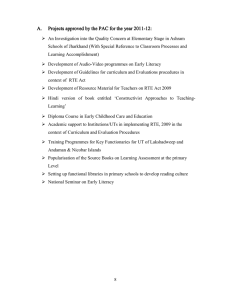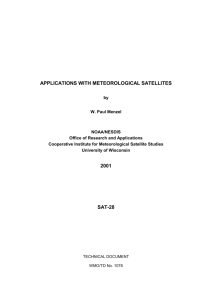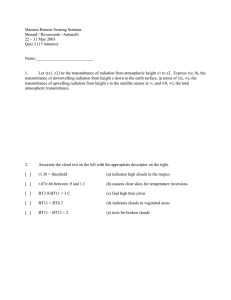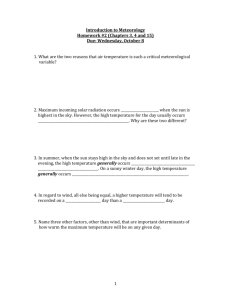APPLICATIONS WITH METEOROLOGICAL SATELLITES by W. Paul Menzel
advertisement
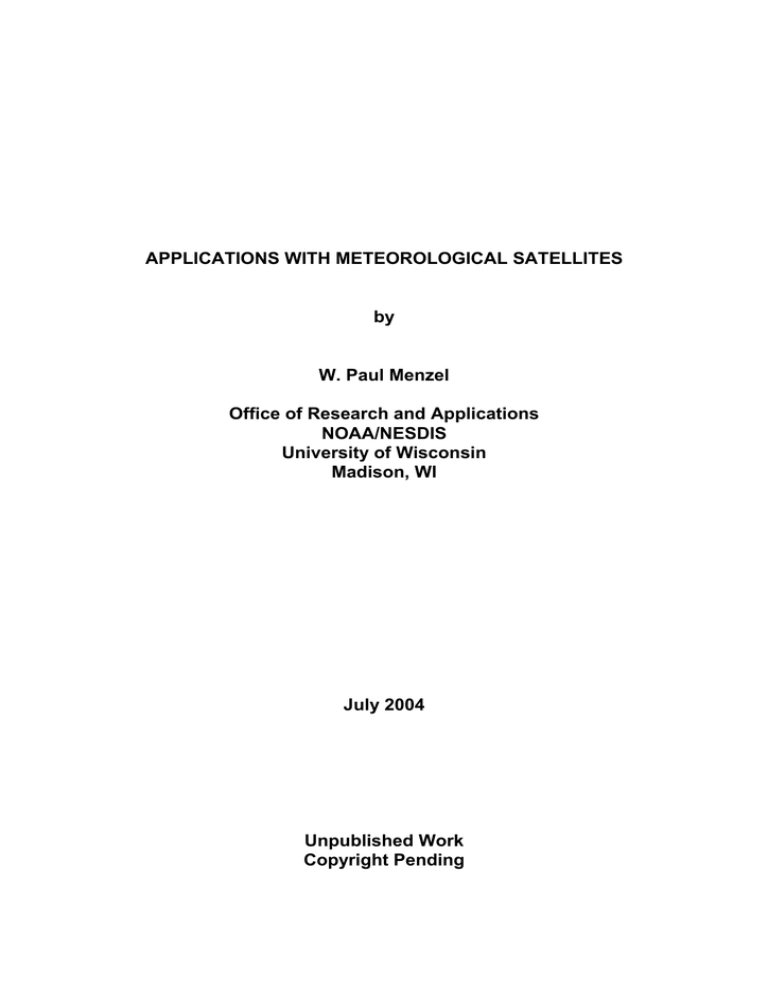
APPLICATIONS WITH METEOROLOGICAL SATELLITES by W. Paul Menzel Office of Research and Applications NOAA/NESDIS University of Wisconsin Madison, WI July 2004 Unpublished Work Copyright Pending TABLE OF CONTENTS Page CHAPTER 1 - EVOLUTION OF SATELLITE METEOROLOGY 1.1 1.2 1.3 1.4 1.5 Before Satellites Evolution of the Polar Orbiting Satellites The Geostationary Program Data Processing Capability Summary 1-1 1-1 1-6 1-9 1-10 CHAPTER 2 - NATURE OF RADIATION 2.1 2.2 2.3 2.4 2.5 Remote Sensing of Radiation Basic Units Definitions of Radiation Historical Development of Planck's Radiation Law Related Derivations 2.5.1 Wien’s Displacement Law 2.5.2 Rayleigh-Jeans Radiation Law 2.5.3 Wien’s Radiation Law 2.5.4 Stefan-Boltzmann Law 2.5.5 Brightness Temperature 2-1 2-1 2-2 2-3 2-6 2-6 2-7 2-7 2-7 2-8 CHAPTER 3 - ABSORPTION, EMISSION, REFLECTION, AND SCATTERING 3.1 3.2 3.3 3.4 3.5 3.6 3.7 3.8 3.9 3.10 3.11 3.12 3.13 3.14 3.15 3.16 Absorption and Emission Conservation of Energy Planetary Albedo Selective Absorption and Emission Absorption (Emission) Line Formation Vibrational and Rotational Spectra Summary of Interactions between Radiation and Matter Beer's Law and Schwarzchild's Equation Atmospheric Scattering The Solar Spectrum Composition of the Earth's Atmosphere Atmospheric Absorption and Emission of Solar Radiation Atmospheric Absorption and Emission of Thermal Radiation Atmospheric Absorption Bands in the IR Spectrum Atmospheric Absorption Bands in the Microwave Spectrum Remote Sensing Regions 3-1 3-1 3-2 3-2 3-4 3-5 3-6 3-7 3-9 3-10 3-11 3-11 3-12 3-13 3-14 3-14 CHAPTER 4 - THE RADIATION BUDGET 4.1 4.2 4.3 4.4 4.5 4.6 4.7 The Mean Global Energy Balance The First Satellite Experiment to Measure Net Radiation The Radiation Budget Distribution of Solar Energy Intercepted by the Earth Solar Heating Rates Infrared Cooling Rates Radiative Equilibrium in a Gray Atmosphere 4-1 4-1 4-2 4-3 4-4 4-5 4-5 CHAPTER 5 - THE RADIATIVE TRANSFER EQUATION (RTE) 5.1 5.2 5.3 5.4 5.5 5.6 5.7 5.8 5.9 5.10 Derivation of RTE Temperature Profile Inversion Transmittance Determinations Fredholm Form of RTE and Direct Linear Inversion Linearization of the RTE Statistical Solutions for the Inversion of the RTE 5.6.1 Statistical Least Squares Regression 5.6.2 Constrained Linear Inversion of RTE 5.6.3 Statistical Regularization 5.6.4 Minimum Information 5.6.5 Empirical Orthogonal Functions Numerical Solutions for the Inversion of the RTE 5.7.1 Chahine Relaxation Method 5.7.2 Example Problem Using Relaxation Method 5.7.3 Smith's Iteration 5.7.4. Example Problem Using Smith's Iteration 5.7.5 Comparison of Chahine and Smith Iteration Solutions Direct Physical Solution 5.8.1 Solving Linear RTE Directly 5.8.2 Simultaneous Direct Physical Solution of the RTE Water Vapor Profile Solutions Microwave Form of RTE 5-1 5-4 5-5 5-6 5-8 5-8 5-9 5-9 5-10 5-11 5-12 5-16 5-16 5-18 5-19 5-20 5-22 5-22 5-22 5-24 5-26 5-28 CHAPTER 6 - DETECTING CLOUDS 6.1 6.2 6.3 6.4 6.5 6.6 RTE in Cloudy Conditions Inferring Clear Sky Radiances in Cloudy Conditions Finding Clouds 6.3.1 Threshold Tests for Finding Cloud 6.3.2 Spatial Uniformity Tests to Find Cloud The Cloud Mask Algorithm 6.4.1 Thick High Clouds 6.4.2 Thin Clouds 6.4.3 Low Clouds 6.4.4 Thin High Clouds 6.4.5 Ancillary Data Requirements 6.4.6 Implementing the Cloud Mask Algorithms 6.4.7 Clear Sky Composite Maps Cloud Properties Derived in a MODIS Granule 6.5.1 Cloud Masking 6.5.2 Cloud Thermodynamic Phase 6.5.3 Cloud Top Pressure and Effective Cloud Amount 6.5.4 Cloud Optical and Microphysical Properties 6.5.5 Detection of Multi-layerd Clouds 6.5.6 Global Gridded Products Ongoing Cloud Climatologies 6.5.1 ISSCP 6.5.2 CLAVR 6.5.3 CO2 Slicing 6-1 6-2 6-3 6-4 6-8 6-10 6-10 6-10 6-11 6-11 6-11 6-12 6-13 6-13 6-13 6-14 6-14 6-15 6-15 6-16 6-17 6-17 6-17 6-18 CHAPTER 7 - SURFACE TEMPERATURE 7.1 7.2. 7.3 7.4 Sea Surface Temperature Determination 7.1.1 Slope Method 7.1.2 Three point Method 7.1.3 Least Squares Method Water Vapor Correction for SST Determinations Accounting for Surface Emissivity in the Determination of SST Estimating Fire Size and Temperature 7-1 7-1 7-2 7-2 7-3 7-5 7-6 CHAPTER 8 - TECHNIQUES FOR DETERMINING ATMOSPHERIC PARAMETERS 8.1 8.2 8.3 8.4 8.5 8.6 Total Water Vapor Estimation 8-1 8.1.1 Split Window Method 8.1.2 Split Window Variance Ratio 8.1.3 Perturbation of Split Window RTE 8.1.4 Microwave Split Window Estimation of Vapor and Liquid Total Ozone Determination 8.2.1 Total Ozone from Numerical Iteration 8.2.2 Physical Retrieval of Total Ozone 8.2.3 HIRS Operational Retrieval of Total Ozone Cloud Height and Effective Emissivity Determination Geopotential Height Determination Microwave Estimation of Tropical Cyclone Intensity Satellite Measurement of Atmospheric Stability 8-1 8-1 8-3 8-3 8-4 8-4 8-5 8-7 8-8 8-10 8-11 8-13 CHAPTER 9 - TECHNIQUES FOR DETERMINING ATMOSPHERIC MOTIONS 9.1 9.2 9.3 9.4 9.5 Atmospheric Motion Geostrophic Winds Gradient Winds Thermal Winds Inferring Winds from Cloud Tracking 9.5.1 Current Operational Procedures 9-1 9-1 9-1 9-2 9-4 9-5 CHAPTER 10 - AN APPLICATION OF GEOSTATIONARY SATELLITE SOUNDING DATA 10.1 10.2 10.3 Detection of Temporal and Spatial Gradients VAS Detection of Rapid Atmospheric Destabilization Operational GOES Sounding Applications 10-1 10-1 10-3 CHAPTER 11 - SATELLITE ORBITS 11.1 11.2. 11.3 11.4 11.5 Orbital Mechanics The Geostationary Orbit Orbital Elements Gravitational Attraction of Non-spherical Earth Sunsynchronous Polar Orbit 11-1 11-2 11-3 11-3 11-4 CHAPTER 12 - RADIOMETER DESIGN CONSIDERATIONS 12.1 12.2 12.3 Components and Performance Characteristics Spectral Separation Design Considerations 12.3.1 Diffraction 12.3.2 The Impulse Response Function 12.3.3 Detector Signal to Noise 12.3.4 Infrared Calibration 12.3.5 Bit Depth 12-1 12-1 12-1 12-1 12-2 12-2 12-3 12-5 CHAPTER 13 - ESTABLISHING CLIMATE DATA RECORDS FROM MULTISPECTRAL MODIS MEASUREMENTS 13.1 13.2 13.3 13.3 13.4 The MODIS Spectral Bands Climate Questions MODIS Product Descriptions MODIS Product Descriptions MODIS and Climate Questions 13-1 13-1 13-4 13-4 13-10 CHAPTER 14 - THE NEXT GENERATION OF SATELLITE SYSTEMS 14.1 14.2 14.3 14.4 14.5 The Global Observing System Meeting Remote Sensing Requirements in the next two decades Current and Future Polar Platforms Current and Future Geostationary Platforms Thoughts on the Future Global Observing Satellite System 14-1 14-2 14-3 14-8 14-9 CHAPTER 15 – INVESTIGATING LAND, OCEAN, AND ATMOSPHERE WITH MULTISPECTRAL MEASUREMENTS 15.1 15.2 15.3 15.4 15.5 15.6 15.7 Introducing Hydra – a multispectral data analysis toolkit Starting Hydra Exploring the MODIS spectral bands Detecting Clouds Mapping Vegetation Investigating a Volcanic Eruption Investigating Coastal Waters 15-1 15-2 15-7 15-18 15-20 15-20 15-22 APPENDIX A - EIGENVALUE PROBLEMS A.1 A.2 A.3 Summary of Matrices Eigenvalue Problems CO2 Vibration Example APPENDIX B - REFERENCES APPENDIX C – PROBLEMS APPENDIX D - EXAMS A-1 A-2 A-4
